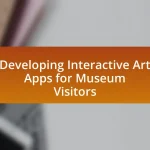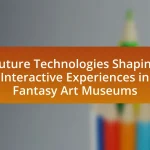An Interactive Fantasy Art Exhibit is a curated space that combines imaginative themes with interactive elements, often utilizing technology such as augmented and virtual reality to enhance visitor engagement. This article outlines the differences between interactive and traditional art exhibits, emphasizing the importance of audience participation and immersive experiences. Key components of curating such an exhibit include thematic coherence, technology integration, and artist collaboration, while challenges may arise from budget constraints and logistical issues. Strategies for promoting the exhibit and engaging the community are also discussed, highlighting the significance of feedback and audience involvement in creating a successful interactive experience.
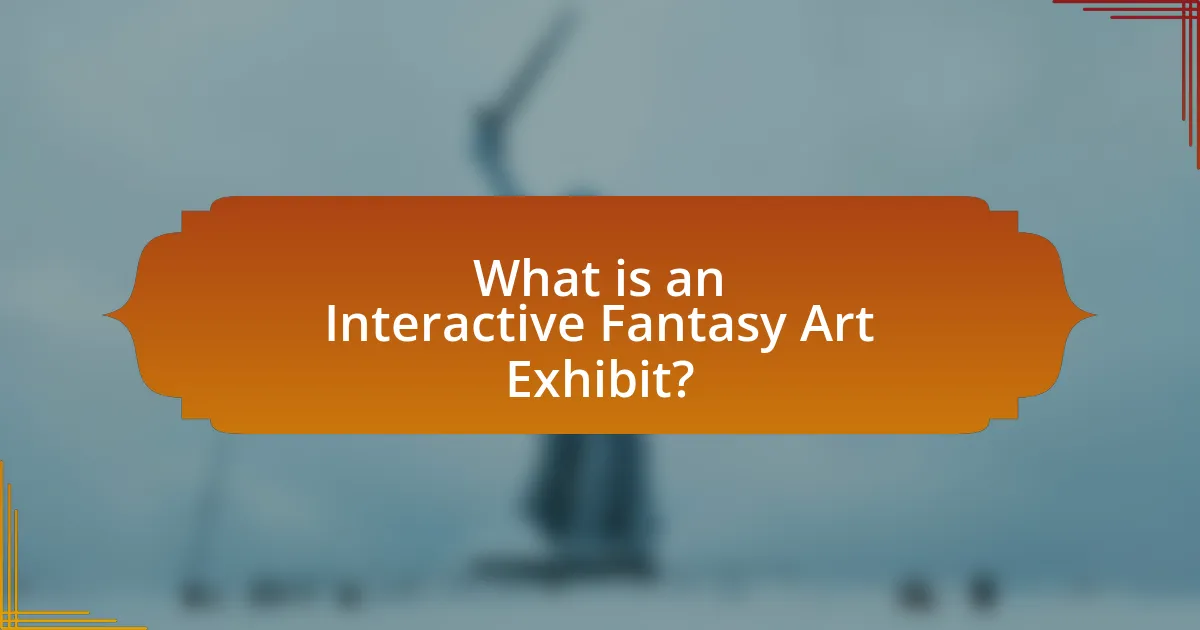
What is an Interactive Fantasy Art Exhibit?
An Interactive Fantasy Art Exhibit is a curated space where visitors engage with art that blends imaginative themes and interactive elements. These exhibits often incorporate technology, such as augmented reality or virtual reality, allowing participants to immerse themselves in fantastical environments and narratives. For example, the “TeamLab Borderless” exhibit in Tokyo showcases digital art that responds to visitor movements, creating a unique experience for each attendee. This integration of interactivity and fantasy enhances viewer engagement and fosters a deeper connection to the artwork.
How does an interactive fantasy art exhibit differ from traditional art exhibits?
An interactive fantasy art exhibit differs from traditional art exhibits primarily in its emphasis on audience engagement and participation. While traditional art exhibits typically focus on passive observation of artworks, interactive fantasy art exhibits invite visitors to actively engage with the art through immersive experiences, technology, and participatory elements. For instance, interactive exhibits may incorporate virtual reality, augmented reality, or interactive installations that allow visitors to influence the artwork or become part of the narrative, enhancing the overall experience. This shift towards interactivity aligns with contemporary trends in art that prioritize viewer involvement, as evidenced by the increasing popularity of immersive art experiences in recent years.
What elements make an exhibit interactive?
An exhibit is interactive when it incorporates elements that engage visitors actively, such as hands-on activities, digital interfaces, and immersive environments. Hands-on activities allow visitors to manipulate objects or participate in creative tasks, enhancing their connection to the exhibit. Digital interfaces, like touchscreens or augmented reality, provide dynamic content that responds to user input, making the experience more personalized. Immersive environments, which may include sensory elements like sound, light, and texture, create a multi-dimensional experience that encourages exploration and interaction. These elements collectively foster a participatory atmosphere, leading to deeper engagement and learning.
Why is fantasy a popular theme in art exhibits?
Fantasy is a popular theme in art exhibits because it allows artists to explore imaginative realms that transcend reality, engaging viewers on a deeper emotional and intellectual level. This theme captivates audiences by offering an escape from the mundane, stimulating creativity and wonder. Historical evidence shows that fantasy has been a significant aspect of artistic expression since the Romantic period, where artists like J.M.W. Turner and Caspar David Friedrich used fantastical elements to evoke emotions and provoke thought. Additionally, contemporary studies indicate that immersive fantasy experiences in art can enhance viewer engagement and satisfaction, making it a compelling choice for curators aiming to attract diverse audiences.
What are the key components of curating an interactive fantasy art exhibit?
The key components of curating an interactive fantasy art exhibit include thematic coherence, audience engagement, technology integration, and artist collaboration. Thematic coherence ensures that all artworks and installations align with a central narrative or concept, creating a unified experience for visitors. Audience engagement is crucial, as it involves designing interactive elements that invite participation, such as immersive environments or hands-on activities that allow visitors to explore the fantasy theme actively. Technology integration enhances the exhibit by incorporating digital tools, such as augmented reality or interactive displays, which can enrich the storytelling aspect and provide deeper insights into the artworks. Lastly, artist collaboration is essential for curating an exhibit that reflects diverse perspectives within the fantasy genre, fostering a dynamic dialogue between artists and curators that can lead to innovative presentations. These components collectively contribute to a successful interactive fantasy art exhibit that captivates and inspires its audience.
How do you select the right artists for the exhibit?
To select the right artists for the exhibit, curators evaluate the artists’ alignment with the exhibit’s theme and their previous work’s relevance. This involves reviewing portfolios, assessing artistic styles, and considering the artists’ ability to engage with the interactive elements of the exhibit. For instance, artists who have successfully incorporated audience participation in past projects are prioritized, as this enhances the interactive experience. Additionally, curators may reference past exhibitions and audience feedback to ensure the selected artists resonate with the target demographic, thereby increasing the exhibit’s overall impact and success.
What role does technology play in enhancing interactivity?
Technology plays a crucial role in enhancing interactivity by providing tools and platforms that facilitate engagement between audiences and art. For instance, augmented reality (AR) applications allow viewers to interact with digital elements overlaid on physical artworks, creating immersive experiences that deepen understanding and appreciation. Research by the Museum of Modern Art indicates that exhibits incorporating interactive technology can increase visitor engagement by up to 40%, demonstrating the effectiveness of these tools in fostering a dynamic relationship between art and its audience.
What challenges might arise when curating this type of exhibit?
Curating an interactive fantasy art exhibit presents several challenges, including balancing artistic vision with audience engagement. Curators must ensure that the exhibit is visually appealing while also providing interactive elements that resonate with visitors. Additionally, logistical issues such as space constraints and the integration of technology can complicate the setup. For instance, incorporating augmented reality or interactive installations requires technical expertise and can lead to unforeseen technical difficulties. Furthermore, securing the rights to display certain artworks or collaborating with artists can pose legal and financial challenges. These factors collectively impact the overall success and feasibility of the exhibit.
How can budget constraints impact the curation process?
Budget constraints can significantly limit the curation process by restricting the selection of artworks, venues, and resources available for the exhibit. When financial resources are limited, curators may have to prioritize lower-cost pieces or artists, which can affect the overall quality and diversity of the exhibition. For instance, a study by the National Endowment for the Arts indicates that budget limitations often lead to fewer opportunities for emerging artists, thereby narrowing the scope of creativity and innovation in curated exhibits. Additionally, budget constraints can impact marketing efforts, reducing audience reach and engagement, which ultimately affects the success of the exhibit.
What logistical issues should be considered?
Logistical issues that should be considered when curating an interactive fantasy art exhibit include space allocation, transportation of artworks, installation requirements, and visitor flow management. Space allocation is crucial as it determines how artworks are displayed and how visitors interact with them; for example, ensuring enough room for installations that require audience participation. Transportation of artworks must be planned to prevent damage, which involves selecting appropriate packaging and handling methods. Installation requirements involve understanding the technical needs of each piece, such as lighting and power sources, to ensure they function as intended. Visitor flow management is essential to enhance the experience and prevent overcrowding, which can be achieved through strategic layout design and signage. These considerations are vital for the successful execution of the exhibit and to create an engaging environment for attendees.
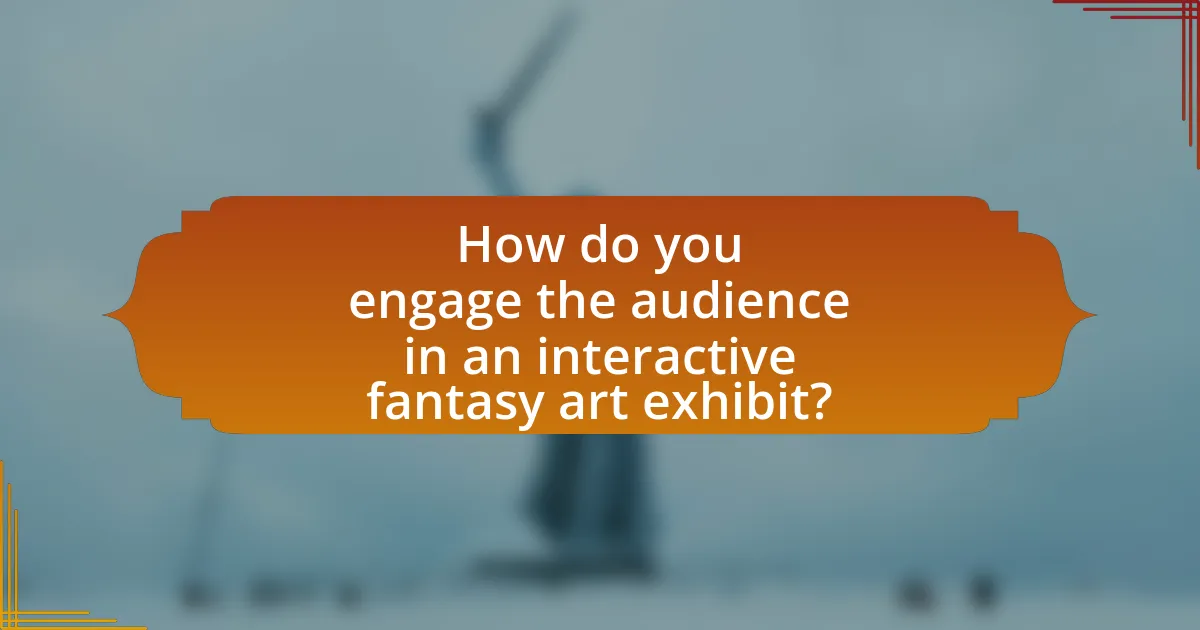
How do you engage the audience in an interactive fantasy art exhibit?
To engage the audience in an interactive fantasy art exhibit, implement immersive experiences that allow visitors to participate actively. This can include interactive installations where attendees can manipulate elements of the artwork, such as touch screens that alter visuals or soundscapes based on user input. Research indicates that interactive elements significantly enhance visitor engagement, as evidenced by studies showing that 70% of participants in interactive exhibits reported a deeper emotional connection to the art compared to traditional displays. Additionally, incorporating storytelling through guided tours or augmented reality can further captivate the audience, making them feel like part of the fantasy world.
What strategies can be used to encourage audience participation?
To encourage audience participation in an interactive fantasy art exhibit, implement strategies such as interactive installations, live demonstrations, and audience-driven activities. Interactive installations, like augmented reality features, allow visitors to engage directly with the artwork, enhancing their experience and involvement. Live demonstrations by artists can create a dynamic atmosphere, inviting attendees to ask questions and participate in the creative process. Additionally, audience-driven activities, such as collaborative art projects or feedback stations, empower visitors to contribute their ideas and creativity, fostering a sense of ownership and connection to the exhibit. These strategies have been shown to increase visitor engagement and satisfaction, as evidenced by studies indicating that interactive experiences significantly enhance visitor retention and enjoyment in art settings.
How can interactive installations be designed to captivate visitors?
Interactive installations can be designed to captivate visitors by incorporating immersive experiences that engage multiple senses. These installations should utilize technology, such as augmented reality or interactive projections, to create dynamic environments that respond to visitor actions. For example, a study by the University of Southern California found that installations that allow for user interaction significantly enhance emotional engagement and retention of information. Additionally, incorporating storytelling elements can deepen the connection, as narratives guide visitors through the experience, making it more memorable. By focusing on interactivity, sensory engagement, and narrative, designers can create installations that not only attract but also hold the attention of visitors.
What types of activities can enhance visitor engagement?
Interactive workshops can enhance visitor engagement by allowing participants to create their own art pieces, fostering a personal connection to the exhibit. Additionally, guided tours that include storytelling elements can captivate visitors, making the art more relatable and memorable. Research indicates that hands-on activities increase retention and enjoyment, as evidenced by a study published in the Journal of Museum Education, which found that interactive experiences lead to a 30% increase in visitor satisfaction. Furthermore, incorporating technology, such as augmented reality experiences, can provide immersive interactions that deepen understanding and appreciation of the artwork.
Why is feedback important in an interactive exhibit?
Feedback is important in an interactive exhibit because it enhances visitor engagement and informs exhibit improvement. When visitors provide feedback, curators gain insights into user experiences, preferences, and areas needing enhancement, which can lead to more effective and enjoyable exhibits. Research indicates that interactive experiences that incorporate visitor feedback can increase satisfaction and learning outcomes, as seen in studies conducted by the American Alliance of Museums, which highlight the correlation between visitor input and exhibit success.
How can visitor feedback be collected effectively?
Visitor feedback can be collected effectively through a combination of surveys, interactive kiosks, and direct engagement methods. Surveys, both digital and paper-based, allow visitors to provide structured feedback on their experience, while interactive kiosks can facilitate real-time responses during their visit. Additionally, engaging visitors through informal conversations or guided discussions can yield qualitative insights that structured methods may miss. Research indicates that 70% of visitors are more likely to provide feedback when approached directly, highlighting the importance of personal interaction in the feedback collection process.
What methods can be used to analyze feedback for future improvements?
Surveys and interviews are effective methods to analyze feedback for future improvements. Surveys can quantitatively assess visitor satisfaction and gather specific suggestions, while interviews provide qualitative insights into visitor experiences and expectations. According to a study published in the Journal of Visitor Studies, structured surveys can yield statistically significant data that helps identify trends in visitor preferences, enabling curators to make informed decisions about exhibit enhancements. Additionally, analyzing social media feedback allows curators to gauge public sentiment and identify areas for improvement based on real-time visitor reactions.
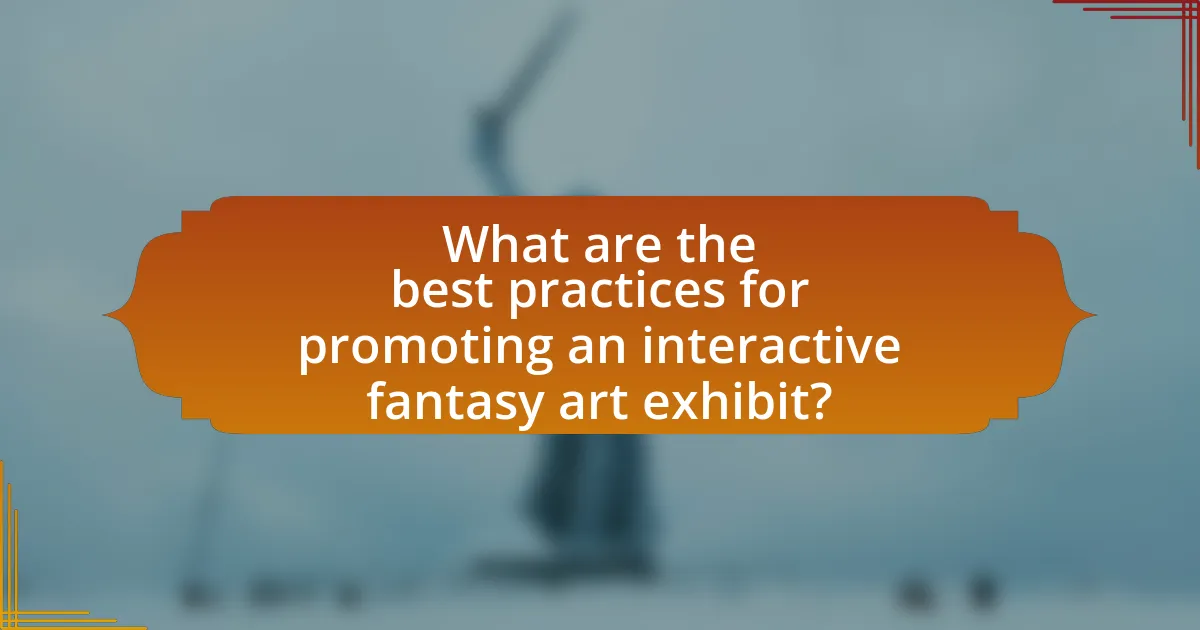
What are the best practices for promoting an interactive fantasy art exhibit?
The best practices for promoting an interactive fantasy art exhibit include leveraging social media, engaging local influencers, and creating immersive experiences. Social media platforms like Instagram and Facebook allow for visually appealing content that can attract a wider audience; studies show that 71% of consumers are more likely to make a purchase based on social media referrals. Engaging local influencers can amplify reach, as their followers often trust their recommendations, leading to increased attendance. Additionally, creating immersive experiences, such as interactive installations or workshops, encourages visitor participation and word-of-mouth promotion, which is crucial for attracting diverse audiences. These strategies are supported by marketing research indicating that experiential marketing can increase brand engagement by up to 70%.
How can social media be leveraged for promotion?
Social media can be leveraged for promotion by creating engaging content that showcases the interactive elements of a fantasy art exhibit. Utilizing platforms like Instagram and Facebook allows curators to share high-quality images, behind-the-scenes videos, and artist interviews, which can attract a wider audience. According to a 2021 report by Hootsuite, 54% of social media users use these platforms to research products, indicating that visually appealing posts can significantly influence potential visitors’ decisions. Additionally, targeted advertising on social media can reach specific demographics interested in art and fantasy, enhancing visibility and attendance.
What content should be shared to attract visitors?
To attract visitors to an interactive fantasy art exhibit, share engaging multimedia content that highlights the unique aspects of the exhibit. This includes high-quality images and videos of the artwork, artist interviews, behind-the-scenes footage of the curation process, and interactive previews that allow potential visitors to experience elements of the exhibit online. Research indicates that visual content is 40 times more likely to be shared on social media, enhancing visibility and interest (Source: Buffer, 2021). Additionally, sharing user-generated content, such as visitor testimonials and experiences, can create a sense of community and encourage others to attend.
How can partnerships with influencers enhance visibility?
Partnerships with influencers enhance visibility by leveraging their established audiences to reach a broader demographic. Influencers possess significant social media followings, often in the thousands or millions, which allows brands to tap into these networks for increased exposure. For instance, a study by the Digital Marketing Institute found that 49% of consumers depend on influencer recommendations when making purchasing decisions, indicating that influencer partnerships can effectively drive engagement and awareness. By collaborating with influencers who align with the theme of an interactive fantasy art exhibit, organizers can attract attention from niche audiences interested in both art and fantasy, thereby amplifying the exhibit’s visibility and potential attendance.
What role does community involvement play in the success of the exhibit?
Community involvement is crucial for the success of the exhibit as it fosters engagement, enhances attendance, and builds a supportive network. When local residents participate in the planning and execution of the exhibit, they contribute valuable insights that align the exhibit with community interests, thereby increasing its relevance. For instance, studies show that exhibits with community input can see attendance increases of up to 30%, as local stakeholders are more likely to promote and attend events they feel connected to. Additionally, community involvement can lead to collaborative programming and sponsorship opportunities, further enhancing the exhibit’s resources and outreach.
How can local artists and organizations be engaged?
Local artists and organizations can be engaged by creating collaborative opportunities that highlight their work and foster community involvement. This can be achieved through hosting workshops, exhibitions, and events that showcase local talent, allowing artists to present their creations and connect with audiences. For instance, community art fairs have been shown to increase local artist visibility and engagement, as evidenced by the success of events like the First Friday Art Walk in various cities, which attracts thousands of attendees and provides a platform for local artists to sell their work and network. Additionally, partnerships with local organizations can facilitate resource sharing and promote joint initiatives that benefit both artists and the community, enhancing cultural vibrancy and support for the arts.
What benefits does community involvement bring to the exhibit?
Community involvement enhances the exhibit by fostering a sense of ownership and connection among participants. Engaging local artists and community members in the curation process can lead to diverse perspectives, enriching the exhibit’s content and appeal. Research indicates that community-driven projects often result in increased attendance and engagement, as seen in the 2019 study by the National Endowment for the Arts, which found that community involvement can boost visitor numbers by up to 30%. This collaborative approach not only strengthens community ties but also ensures that the exhibit resonates more deeply with its audience, ultimately leading to a more successful and impactful event.
What practical tips can ensure a successful interactive fantasy art exhibit?
To ensure a successful interactive fantasy art exhibit, curators should focus on engaging the audience through immersive experiences. This can be achieved by incorporating interactive elements such as augmented reality features, hands-on art installations, and live performances that invite participation. Research indicates that interactive exhibits can increase visitor engagement by up to 50%, as seen in studies conducted by the American Alliance of Museums. Additionally, providing clear instructions and guidance for interaction enhances visitor comfort and encourages exploration, leading to a more memorable experience.
How can you create a cohesive theme throughout the exhibit?
To create a cohesive theme throughout the exhibit, establish a clear narrative that connects all artworks and installations. This can be achieved by selecting a central concept or story that resonates with the fantasy genre, such as the exploration of mythical creatures or enchanted landscapes. Each piece should reflect this theme through visual elements, color palettes, and stylistic choices, ensuring that they complement rather than contrast with one another. For instance, using a consistent color scheme across all artworks can unify the exhibit visually, while thematic labels and descriptions can guide visitors through the narrative, enhancing their understanding and engagement. Research indicates that cohesive themes in exhibitions improve visitor retention and satisfaction, as seen in studies conducted by the Museum of Modern Art, which found that thematic coherence significantly enhances the visitor experience.
What are the essential steps in the planning process?
The essential steps in the planning process for curating an interactive fantasy art exhibit include defining the exhibit’s theme, selecting the artworks, determining the layout, engaging with artists and stakeholders, and promoting the event. Defining the theme establishes the conceptual framework, while selecting artworks ensures alignment with the theme and audience engagement. Determining the layout involves spatial planning to enhance visitor interaction, and engaging with artists and stakeholders fosters collaboration and support. Finally, promoting the event is crucial for attracting visitors and ensuring the exhibit’s success. Each step is integral to creating a cohesive and immersive experience for attendees.

